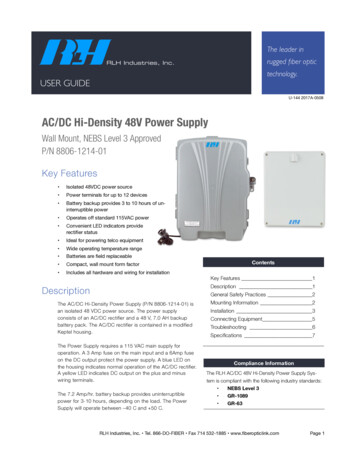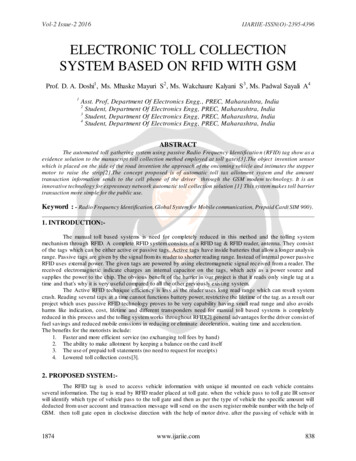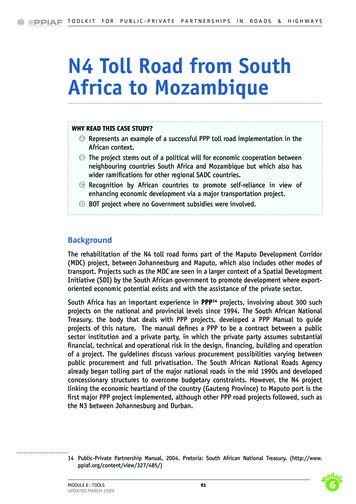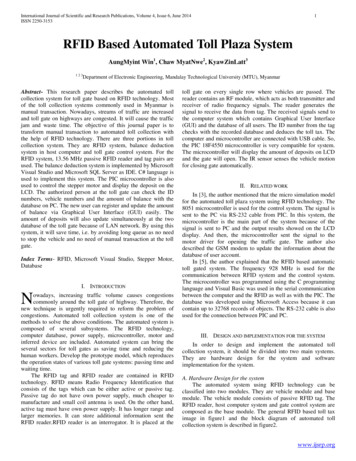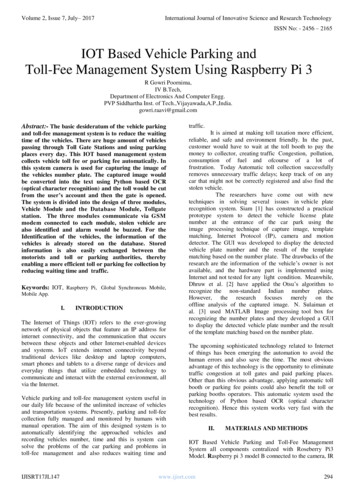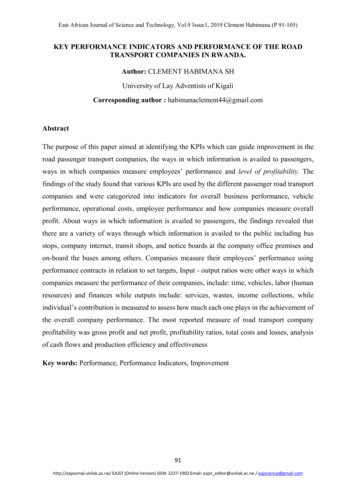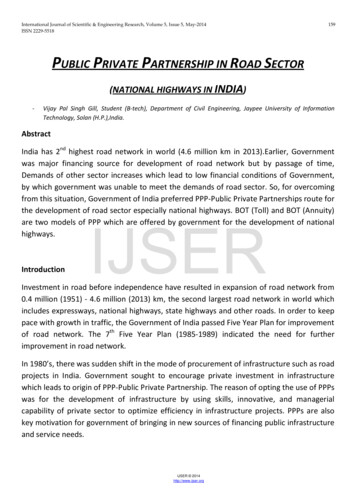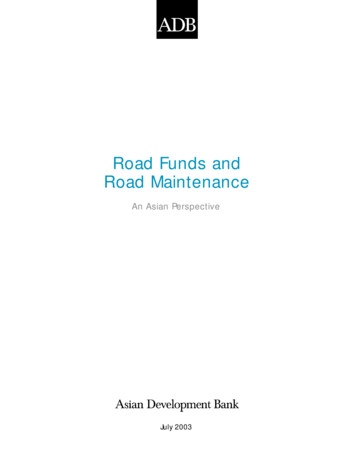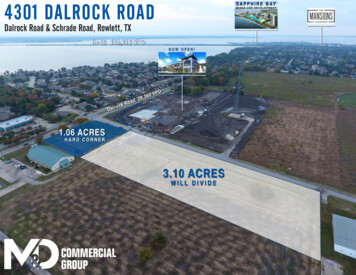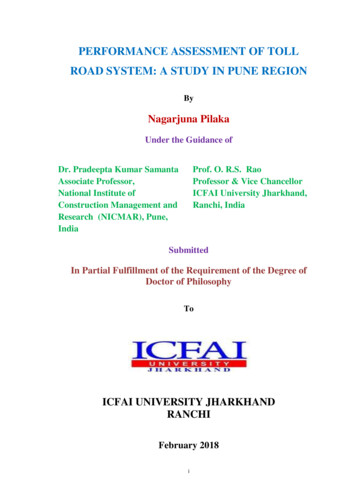
Transcription
PERFORMANCE ASSESSMENT OF TOLLROAD SYSTEM: A STUDY IN PUNE REGIONByNagarjuna PilakaUnder the Guidance ofDr. Pradeepta Kumar SamantaAssociate Professor,National Institute ofConstruction Management andResearch (NICMAR), Pune,IndiaProf. O. R.S. RaoProfessor & Vice ChancellorICFAI University Jharkhand,Ranchi, IndiaSubmittedIn Partial Fulfillment of the Requirement of the Degree ofDoctor of PhilosophyToICFAI UNIVERSITY JHARKHANDRANCHIFebruary 2018i
Declaration of AuthorshipI declare that this thesis entitled “Performance Assessment of Toll Road System: AStudy in Pune Region” submitted by me in fulfillment of the requirements for theaward of the degree of Doctor of Philosophy of the ICFAI University Jharkhand, Ranchiis my own work. It contains no material previously published or written by anotherperson nor material which has been accepted for the award of any other degree ordiploma of the university or other institute of higher learning, except where dueacknowledgment has been made in the text. I further confirm that the thesis complieswith the Plagiarism Guidelines of the ICFAI University, Jharkhand.Nagarjuna PilakaDate:Place:ii
AcknowledgmentsIt is my first and foremost duty to express my sincere thanks and deep sense ofindebtedness to my Supervisor Prof. O.R.S Rao Professor and Vice–Chancellor ofICFAI University, Jharkhand who has guided me and taken keen interest in my researchwork. His scholarly guidance and inspiring suggestions have helped me in carrying outthe present research work. He has been very helpful in discussing the matters pertainingto the study and offered constructive suggestions during the course of the work. Gratefulthanks are due to him. His guidance helped me in all time of research and writing of thisthesis. I would not have imagined having a better advisor and mentor for my Ph.D study.I cannot dream about this thesis without the strong support, guidance and co-operation ofMy Co-Supervisor Dr. Pradeepta Kumar Samanta, Associate Professor, NationalInstitute of Construction Management And Research, Pune. Words are inadequate toexpress my deep sense of gratitude to him for his invaluable guidance. In fact, I havelearnt a great deal from Dr. Pradeepta Kumar Samanta regarding research methodology,particularly the tools and techniques used in the present study. Without his valuableguidance and suggestions, this research project would not have been possibleI would like to take a moment to express my sincere thanks and deep indebtedness toDr. Mangesh G. Korgaonker, Director General, NICMAR for giving me theopportunity in NICMAR and providing me all resources for this study. I am deeplygrateful for his wisdom, experience, mentorship and guidance without which this studywould not have been possible. He constantly encourages the faculty to conduct researchand always provides his moral support. I look forward to continuing to work with himand undertaking many more fruitful endeavours in the futureiii
I would also thank rest of my thesis committee for their insightful comments andencouragement.I also thank my school Dean, Dr. Mona N Shah, my Colleagues, NICMAR Sr. librarianMr. A.R. Jadhav and friends for stimulating discussions and constant motivation duringmy research study. I thank in particular Mr. Ganesh B. Gite who helped a lot in typingthis report.I am also thankful to the Toll Plaza officials, staff, all respondents and students for theirvaluable cooperation and help in the course of data collection.Last, but not the least, I would like to thank my Wife, my Daughters, my Parents,Brothers and Sisters and all my Relatives for supporting me spiritually throughout theresearch study and my life in general.Date:Nagarjuna PilakaPlace:iv
Thesis Completion CertificateThis is to certify that the thesis on ―Performance Assessment Of Toll Road System: AStudy In Pune Region‖ by Nagarjuna Pilaka, in Partial fulfillment of the requirementsfor the award of the Degree of Doctor of Philosophy is an original work carried out byhim under our joint guidance.We also certify that the thesis complies with thePlagiarism Guidelines of the ICFAI University, Jharkhand. It is certified that the workhas not been submitted anywhere else for the award of any other diploma or degree ofthis or any other University.Dr. Pradeepta Kumar SamantaProf. O. R. S RaoCo-SupervisorSupervisorv
ContentsDeclaration of AuthorshipiiAcknowledgmentsiiiThesis Completion CertificatevAbstractxiiChapter 1: dObjectives and Scope of the StudyMotivation for the StudyOverview of Research ApproachContribution of ResearchOutline of ChaptersSummaryChapter 2: Literature Review82.12.22.32.42.52.62.72.8Global Toll Road ScenarioToll Road System in IndiaToll Road Economic AdvantagesToll Road Operations and Performance IndicatorsToll Road ServicesModern Tolling Methods and TechnologyResearch GapSummary812222630385556Chapter 3: Performance Of Toll Road System: Conceptual 616162656768IntroductionOperational Objectives of Functional Toll RoadsDefining Performance IndicatorsPerformance Indicator and Performance IndexApplication of Performance Indicators (PI)How to Obtain PIsClassification Based On The Nature Of PIsModel of Performance MeasurementMethod to Calculate PIsSummaryChapter 4: Research Design and Methodology704.14.24.34.470717172OverviewResearch QuestionsResearch ObjectivesData Collection Methodsvi
4.54.64.7Analysis TechniquesStudy HypothesesSummary798082Chapter 5: Pilot Study835.15.25.35.45.58383848697Purpose of the Pilot StudyMethodologyData CollectionData AnalysisPilot Study FindingsChapter 6: Analysis of Data, Results and Analysis TechniquesToll Traffic and Toll Financial Data AnalysisAnalysis of Data on Toll Plaza OperationsAnalysis of Road User Survey DataRoad User Study Statistical AnalysisLinking Relative Performance of Toll ways – Overall Analysis ofPerformance IndicatorsSummary222227Chapter 7: Summary and 236236Summary of Performance of Roads Across various IndicatorsTolling Operations Efficiency RankingToll Ways Services PerformanceRecommendations for Improving of ServicesContribution of the StudyLimitations of the StudyScope for Future Research239BIBLIOGRAPHYAPPENDICESAppendix IAppendix IIAppendix IIIAppendix IVAppendix VAppendix VITraffic Data Collection FormatQuestionnaire for Tolling OperationsQuestionnaire for Road User SurveyOperation Maintenance Cost of Toll Roads under StudyStudy Area LayoutPhotographs of Toll Ways and Toll Plazasvii253254255260261262
List of FiguresFigure 2.1: BOT Projects Awarded by NHAI to Private PlayersFigure 2.2: Electronic Toll Collection SystemFigure 2.3: Electronic Toll Collection Lane SystemFigure 2.4: On Board Unit DevicesFigure 2.5: Smart CardsFigure 4.1: Lay out of the Toll PlazasFigure 5.1: Satisfactions Score on Segments of Toll WaysFigure 5.2: Satisfactions about Signs and SignalsFigure 5.3: Satisfactions about Traffic ControlFigure 5.4: Satisfactions about AmbulancesFigure 5.5: Satisfactions about Cash BarriersFigure 5.6: Satisfactions about Recovery VansFigure 5.7: Satisfactions about Police PetrolFigure 5.8: Satisfactions about CC TVFigure 5.9: Satisfactions about Emergency PhonesFigure 5.10: Satisfactions about Parking LotsFigure 5.11: Satisfactions about Rest HousesFigure 5.12: Satisfactions about Toilet FacilitiesFigure 5.13: Satisfactions about Filling StationsFigure 5.14: Satisfactions about Small Repair ShopsFigure 5.15: Satisfactions about Pickup Bus StationsFigure 6.1: Toll Traffic Trend (Pune-Nagar Road)Figure 6.2: Toll Revenue Trend (Pune-Nagar Road)Figure 6.3: Operating Ratio Trend (Pune-Nagar Road)Figure 6.4: Toll Traffic Trend (Pune-Nashik Road)Figure 6.5: Toll Revenue Trend (Pune-Nashik Road)Figure 6.6: Operating Ratio Trend (Pune-Nashik Road)Figure 6.7: Toll Traffic Trend (Pune-Mumbai Road)Figure 6.8: Toll Revenue Trend (Pune-Mumbai Road)Figure 6.9: Operating Ratio Trend (Pune-Mumbai Road)Figure 6.10: Toll Traffic Trend (Pune-Satara Road)Figure 6.11: Toll Revenue Trend (Pune-Satara Road)Figure 6.12: Operating Ratio Trend (Pune-Satara Road)Figure 6.13: Toll Traffic Trend (Pune-Satara Road)Figure 6.14: Toll Revenue Trend (Pune-Solapur Road)Figure 6.15: Operating Ratio Trend (Pune-Solapur Road)Figure 6.16: Toll Traffic Trend (Pune-Solapur 7108108109110110111112112113114114115116116117118
Figure 6.17: Toll Revenue Trend (Pune-Mumbai Expressway)Figure 6.18: Operating Ratio Trend (Pune-Mumbai Expressway)Figure 6.19: Respondent Profile – Pune-Ahmednagar HighwayFigure 6.20: Respondent Profile – Pune-Nashik HighwayFigure 6.21: Respondent Profile – Pune-Satara HighwayFigure 6.22: Respondent Profile – Pune-Solapur HighwayFigure 6.23: Respondent Profile – Pune-Mumbai HighwayFigure 6.24: Respondent Profile – Pune-Mumbai Express WayFigure 6.25: Respondent Profile – OverallFigure 6.26: Opinion about Increasing Travel SpeedFigure 6.27: Opinion about Increasing Reduced Commuting Time Across tollRoadsFigure 6.28: Opinion about Increasing Savings in Fuel expenses Across toll RoadsFigure 6.29: Opinion about Reduced Environmental Pollution Across toll RoadsFigure 6.30: Opinion about Decreased Road accidents Across toll RoadsFigure 6.31: Opinion about Industrial Township Development Across toll RoadsFigure 6.32: Percentage of Respondents (increase in speed)Figure 6.33: Percentage of Respondents on Reduced Commuting TimeFigure 6.34: Percentage of Respondents on Saving in Fuel ExpenseFigure 6.35: Percentage of Respondents Reduced environmental pollutionFigure 6.36: Percentage of Respondents on Decreased Road AccidentsFigure 6.37: Percentage of Respondents on Industrial Township DevelopmentFigure 6.38: Road wise average road service performance scores (across allparameters)Figure 6.39: Scree PlotFigure 6.40: Component Plot in Rotated SpaceFigure 6.41: Radar-chart of road user 69171172172173173174174178219221227
List of TablesTable 2.1: Various Phases of NHDP14Table 2.2: Summary of Relevant Literature Survey42Table 3.1: Model Calculation for Select Indicators64Table 3.2: Key Performance Areas and Indicators Framework66Table 3.3: Sample Performance Index68Table 4.1: Road User Service Indicators75Table 4.2: Sample Size in Study Area Road Wise78Table 5.1: Road Way Services84Table 5.2: Sample of Profile of the Pilot Study85Table 5.3: Purpose of Travel87Table 5.4: Duration of Travel87Table 5.5: Willingness to Pay88Table 5.6: Average Parameters Course88Table 5.7: Proportion of Satisfaction With Respect to Roads92Table 6.1: Toll Traffic at Toll Ways102Table 6.2: Toll Rates at Various Toll Plazas103Table 6.3: Toll Revenue (Rs. In Lakhs)104Table 6.4: Operating Ratio105Table 6.5: Toll Revenue Grand Total Year Wise (Rs. In Lakhs)105Table 6.6: Summary of Statistics-Pune Nagar Road106Table 6.7: Summary of Statistics-Pune Nashik Road106Table 6.8: Summary of Statistics-Pune Mumbai Road106Table 6.9: Summary of Statistics-Pune Satara Road107Table 6.10: Summary of Statistics-Pune Solapur Road107Table 6.11: Summary of Statistics-Pune Mumbai Expressway107Table 6.12: Quantitative Parameters124Table 6.13: Qualitative Parameters125Table 6.14: Ranking of Toll Plazas126Table 6.15: Sample Size in Various Cases of Toll Roads135Table 6.16: Percentage Distribution of Respondent Profile137Table 6.17: Percentage Distribution of Toll Payers across the Roads141Table 6.18: Percentage distribution of users of Toll passes142Table 6.19: Opinion on Toll Prices144Table 6.20: Mode of Toll Payment145x
Table 6.21: Awareness about Toll Payment147Table 6.22: Opinion on Complaint Redressal System148Table 6.23: Analysis of Factors Affecting Travel150Table 6.24: Analysis of factors affecting travel151Table 6.25: Analysis of Complaints Affecting Travel154Table 6.26: Overall Summary of Complaints155Table 6.27: Roadway Service indicators175Table 6.28: Comparative Segmental Average Scores of Six Roadways178Table 6.29: Descriptive Statistics for Road Service Scores (smoothness)184Table 6.30: ANOVA Results185Table 6.31: POST HOC TEST for the Variable Smoothness of the road (S)186Table 6.32: Analysis of Pedestrian Facilities (Indicator 4)187Table 6.33: ANOVA Results (Indicator 4)187Table 6.34: F Test Analysis188Table 6.35: Reliability Notes189Table 6.36: Case Processing Summary190Table 6.37: Reliability Statistics190Table 6.38: Item Statistics190Table 6.39: Inter-Item Correlation Matrix191Table 6.40: Item-Total Statistics192Table 6.41: Scale Statistics192Table 6.42: One-way Anova Notes193Table 6.43: ANOVA194Table 6.44: Multiple Comparisons196Table 6.45: Factor Analysis Notes215Table 6.46: Communalities217Table 6.47: Total Variance Explained218Table 6.48: Component Matrix220Table 6.49: Component Transformation Matrix220Table 6.50: Inter Correlation among Parameters223Table 6.51: Co-Relation amongst Parameters225xi
ABSTRACTThe toll road system has been historically accounted for the bulk of the financing ofhighway network. By building a toll roadway, it is possible to provide a number ofimproved services to the road users, which can be measured in order to ensure that theydeliver the outcomes that are envisaged. In toll road sector, the major stakeholders,typically the Government and the contractors are responsible for development of the tollproject and delivering operational services, using associated technologies, therebyfulfilling the primary objective of creating a tollway, being the customers‘ satisfaction.Toll roads have been gaining popularity for more than a decade in India. A few yearsafter the tollway projects are put into operational mode, they are expected see a lot oftraffic every day comprising a variety of vehicles ranging from personal vehicles, lightand heavy commercial to multi axle trucks and so on. As per the prescribed Governmentpolicy guidelines, toll fares are levied on most of the vehicles using toll road facility. Itis important to provide good quality road infrastructure as well as other requiredamenities to the road users, with focus on enhancing the safety measures.There are six major toll roads on the prominent highway corridors in and around Puneregion.The region has a toll road system comprising ‗toll road segments‘ and ‗anetwork of toll plazas‘. The toll plazas are set up by the private developers for collectingtoll from the vehicles passing through the toll road as part of the toll road contractagreement made with the Government. Most of the road users feel that roads in the studyregion are not up to the desired operational standards. As the contractors do not followreportedly stipulated norms, as laid down in the roadway Operation & Maintenancecontract and fail to perform contractual obligations, the road users do not get basicservices like toilets and parking base along the roads. Therefore citizens are not ready toxii
pay toll but they cannot refuse. As per the general feedback received from the road usersacross the region, they are unwilling to pay the toll fees for the roads that have beencommercially operational for a long time as the operators have recovered the costs andare not taking any steps to reduce travel time. They are also questioning why toll fees arelevied on all types of vehicles. Most of these toll roads are mainly towards the majorcities like Mumbai, Satara, Nashik and Solapur and carry huge amount of trafficeveryday and generate a lot of toll revenue for the road operators. The toll collectionfigures across the toll organisations have been rising year-on-year on account of thehigher traffic volumes generated on some major roadway corridors in the region,particularly with high percentage of cars and commercial vehicles and contributing to theregional economy to a considerable extent. Moreover, it is believed that the tollwaysbuilt around the region have brought in significant socio-economic development throughnumerous travel benefits in terms of savings in commuters travel time, low vehicleoperation cost, reduction in rate of accidents, etc.The tolling operation needs to be looked upon as a distinct and important aspect in aproject‘s success. With a large number of projects not meeting their financial targets,senior management personnel are now getting involved in toll operations. This hasresulted in tolling operations becoming a separate and independent entity within theorganization. However, the toll road system under the study comprising these toll waysappears to be not functionally up to the mark with some visible deficiencies in majorfunctional areas such as tolling operations, roadway services and so on. So, the keyquestion remains here as to how to understand and assess the relative performance of thetollways , operating virtually under similar physical and traffic conditions and how thesetoll organisations compare on key operational performance Indices . It calls for a detailedxiii
study on the tollway characteristics in terms of traffic, toll revenue, operationalstandards, tollway user services, etc.The present study is therefore intended to analyse the operational standards and assessthe level of performance of the Toll Road System in the Pune region, covering Six Tollway Stretches. The assessment exercise is considered very important keeping in view:i)The lack of commitment on the part of toll road operators in providing desired tollroad related services.ii) No proper mechanism in place for the review of operational standardsiii) The concerns of the public with the regulation of toll norm prevailing in the region.iv) Dissatisfaction of the road users with aspects like the prevailing condition of theroads and long waiting time at toll plazasThe study therefore contemplates developing performance framework for evaluatingoperational toll roads with primary objective of identifying performance indicators invarious operational areas.The framework is primarily concerned with identifyingperformance indicators in key performance areas, assessing roadways for operationaldeficiencies, finding causal factors for the same and suggesting ways for furtherimprovement of the system. Three different methodologies are used to collect data onvarious factors considered in the study, after conducting literature survey on theseperformance criteria.The primary data collection methodologies broadly include toll traffic studies, structuredobservation study and a survey using a structured questionnaire. At the outset, trafficstudies across various toll plaza sites were conducted in order to capture a variety ofvehicles using toll ways and determine toll revenue thereof. The observation of studyxiv
involved a field visit at the toll plazas with an observation sheet with clearly definedformat for capturing various aspects or elements of the toll operational zone and that ofroad corridors. The Questionnaire Survey was employed for gathering the data on usersatisfaction parameters as it is a way of assessing the system performances in terms ofuser service quality and bringing in improvement in the system. The data collectiontechniques are explained in detail in Chapter 4, Research design.Responses from the survey were analysed through quantitative methods as covered in thechapter 6, Analysis of Data. On the analysis front, firstly it provides and compares thefinancial indicators of the toll roads, toll rates for different class of vehicles along withvolume of traffic, operational expenditures of the toll ways, toll revenue and operatingratios as part of the analyses. It is observed that due to lack of deployment of advancedtolling technologies, people have to wait for long durations at toll collection sites. Anelaborate year wise and toll road wise revenue are presented along with the details oftraffic count relating to various categories of vehicles in Chapter 6.Growth of the overall traffic density, for the tollways under study, has been found to bein the order of 7% to 12 % during the period 2014-2016. The toll revenues haveincreased by 7% to 10% during this period. Heavy Commercial Vehicles, Multi-axlevehicles and Cars contribute to huge revenue across these toll roads in the region. Thetop grosser projects are Pune- Mumbai Expressway and Pune Mumbai Highway whichjointly generated whopping toll revenue of about Rs.1200 Crore per year on averageduring this period. Another important indicator that has been derived for assessing thesetoll organisations is Operating Ratio (OR). It is an important and commonly usedindicator for assessing financial condition of big organisations dealing with toll roadsprojects. These organisations require a large growth in revenue to maintain theiroperations. The estimated OR is in the range of 1.15% - 10.5% across these toll projectsxv
which indicate that, these projects are doing exceedingly well on the financial front, asthe ratios found are far below the envisaged normal target.Secondly, the toll booths set up on the toll roads are evaluated through twenty fourelements under four key dimensions related to tolling operations at booth level, andassessed as best, medium and poor performing toll booths.It was found that theoperational situation is not very satisfactory, as most of the toll booths lack essentialtolling infrastructure.The performance in terms of physical operations of tolling are measured across the tollbooths and compared on performance efficiency scores obtained through a speciallydevised performance measurement process. It is found that none of the toll booths scoredmore than 60 points out of 100 points. However theShirur toll plaza on Pune-Ahmednagar Road, Anewadi toll plaza on Pune–Satara, Talegaon toll plaza on PuneMumbai Highway road obtained 1st, 2nd and 3rd positions respectively due to wellmaintained and adequate facilities. Other five toll booths have been termed poorperformers that need to work harder to improve their operational conditions.At the same time tollways are also assessed almost through similar procedure ofemploying questionnaire survey based on sample data of 336 commuters across all theroads, covering various types of vehicles. It was found that the tollways compare poorlyon several service indicators thereby perform below par. Relevant statistical analysesinvolving reliability, hypothesis testing, ANOVA and factor analyses have beenconducted for validating the results of study. A perception study of road users hasshown that their average level of satisfaction is poor with all the six roadways understudy, though there were wide individual variations among the roads.xvi
The Pune -Ahmednagar (PA) Road secured the highest performance level with theoverall Index value of 2.57, followed by Pune-Mumbai Expressway (PEx) with 2.47 andPN, with 2.43 ranking the first, second and third respectively in terms of their overallperformance standard compared to others. The Pune-Satara (PS) road came out to be theworst performing road with 6th position in quality of service ranking of the Pune regiontoll roads, followed by Pune-Mumbai (PM) highway and Pune-Solapur ( PSo) ranking 4and 5 respectively. The rankings given to them on computation of quality score are justrelative and no toll road could be considered perfect. However, there is scope for betterperformance in each of these roads. The region recorded a wide range of problems suchas issues with the Government toll policy, poor roadway maintenance and delay at tollplazas, etc. across the region for the past several years. Roadway maintenance problemsand skewed toll policy emerged as the top reasons for toll roads falling short indelivering services of standard quality.Lastly, the results are comprehensively presented and causal factors are found out for thetollway system not performing at par and suitable recommendations are given to bringthe system in par with desirable quality standards across various service indicators. Thestudy came out with some recommendations which are presented very broadly in thefollowing paragraph.The National Highway Authority of India (NHAI) should not only look at toll tariffstructures for passengers and toll operators but also set standards of performance andefficiency for customer satisfaction. Particularly in this case the road users‘ satisfactionin both, tolling operations and roadway services that would be enforceable under theTollways Act. The regulator, the NHAI should be responsible for recommending forpassengers‘ toll fares, setting performance standards for toll operations and must providexvii
guidance on quantity and quality of service provided to passengers. These may includesetting quantitative and qualitative standards including the number of toll lanes, presenceof weighing bridges, the electronic toll collection systems, traffic wardens, roadwaysurface smoothness, safety standards and road user amenities.xviii
CHAPTER 1INTRODUCTION1.1BackgroundMost developing countries are in urgent need of highway construction programmes. Theprimary objective of road infrastructure development project is to generate benefits to theusers, such as, convenience, cost savings, reduced travel time, and thereby acceleratingeconomic development in the influence area of the road project. No infrastructure projectshould be undertaken unless the economic benefits criteria and economic viability isfully established prior to the decision on investment in road projects (Chakraborthy,1996). Traditionally, highways in India have been viewed as a public convenience thatmust be financed and operated by the public sector. But the Govt. faced fundingconstraints in later stage development because of chronic budgetary problems. The sectorwitnessed the emergence of Public Private Partnership model in highway development inearly 1990s and subsequently, the National Highway Authority of India (NHAI) was setup in the year 1995 for overseeing the functioning of the private entities in the highwaydevelopment thereafter (Subra, 1999). Since then a number of projects have beenimplemented on PPP model, particularly through Build, Operate and Transfer (BOT)contract. Consequently, it has become increasingly accepted that highways should bebuilt, financed, and operated by private firms and that road user should pay toll for usingthem. Moreover, users are more likely to accept the concept of paying for roads ownedby private sector that builds highways faster and more efficiently than state-owned firms.However, the National Highway Authority of India (NHAI) continues to carry outregulatory functions including monitoring the projects, setting up quality norms, etc.During the specified period prescribed in PPP contract, the private firm operates and1
maintains the infrastructure created, thereby assuring road users of adequate qualityservices, safety, and security standards on the toll way stretches.Thus, the system of toll road has been operating for quite some time in India and hasbenefitted all passengers travelling on toll roads. While the toll collection and recoveringthe project development costs are the key objectives of private entities, the issues arisingout of providing quality services to the toll road commuters is the matter of highestconcern and need to be addressed adequately.It is mandated to ensure that the highway users are provided with quality services for thetoll they pay. It ensures that the road contractor and developers maintain the standardsthat they are supposed to, according to the concession agreement between the contractorsand NHAI, as after all the commuter is levied toll for not just the highway usage butcertain services as well. But, it is often observed that once the road is ready for operation,toll collection starts and service performance parameters are forgotten. Theconcessionaire continues to collect toll from the ever-increasing traffic and neglectsquality services to the commuters and deviates from the service deliveries as promised inthe concession agreement. (Mamuni Das, 2010)Road User Services are the advantages or service benefits accruing to the vehicle driversor owners or occupants through features like road safety, comfort, convenience, etc.(Khanna, 1993). For example, a group of services the toll road operators are expected toprovide to the travelling public include patrolling services, ambulance facilities at thetime of accidents, communication facilities, parking lots, rest rooms along road side,motels etc.2
1.2Objectives and Scope of the StudyThis study aims to take a holistic approach to performance of toll roads through analysisof the performance indicators, both quantitative and qualitative, with the following mainobjectives 1.To identify specific indicators to evaluate performance of toll roads2.To develop the performance evaluation criteria to measure performance of toll roads3.To study the causal factors for performance deficiency and suggest measures forimprovement in key performance areasScope of StudyThe study is a modest attempt to develop a performance evaluation framework for tollroad network in Pune region, which covers performance assessment of the operationaltoll roads in the toll way network of nearly 500 km., including toll posts in the region.The performance of six toll roads and eight toll plazas are analyzed against standardcriteria that are set, based on key objectives of the projects. The study is intended tocover a Holistic Performance Model-a novel concept in researchers‘ perspective. Thefocus is on three key components of toll way operational system- (i) Traffic and TollRevenue (ii) Toll Plaza Operations and (iii) Public opinion about road user amenities.The Pune tollway system will be assessed on corresponding performance parameters,such as system output (toll traffic, toll revenue, etc.), tolling operations services and roadway quality of service to travelers. Then the perfor
Construction Management and Research (NICMAR), Pune, India Prof. O. R.S. Rao . this research project would not have been possible . 6.2 Toll Traffic and Toll Financial Data Analysis 100 6.3 Analysis of Data on Toll Plaza Operations 120
